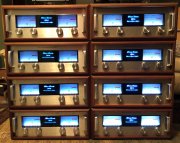Turboj5525
New Around These Parts
- Joined
- Dec 18, 2021
- Messages
- 39
So I would love to hear pros, cons and opinions. I was going to run my marantz 2325 as a preamp and use some KLH kendalls I have. These speakers are rated for 250w. Just wondering if it will be a small improvement in headroom to go from the 2325 to the PL400. For this reason I decided I wanted the 700. I'm trying to spend less than $600 for just the amp and that's been difficult. I obviously have to throw the whole White Oak catalog at it after I get it also lol... That has me considering the 400. Let me know what you guys think. I watched all of Mark's videos on the tube where he did the upgrades from WO to the 400 and then the 700. I recall him mentioning the 400 being warmer sounding but also getting fairly hot after long sessions. I like to listen pretty loud so that also made me think 700. I may be over thinking it all and I'm sure I would be impressed with the 400. I would still like to know everyone's advice and opinions who actually have them and love them.
Thanks in advance everyone.
Thanks in advance everyone.
Last edited:



